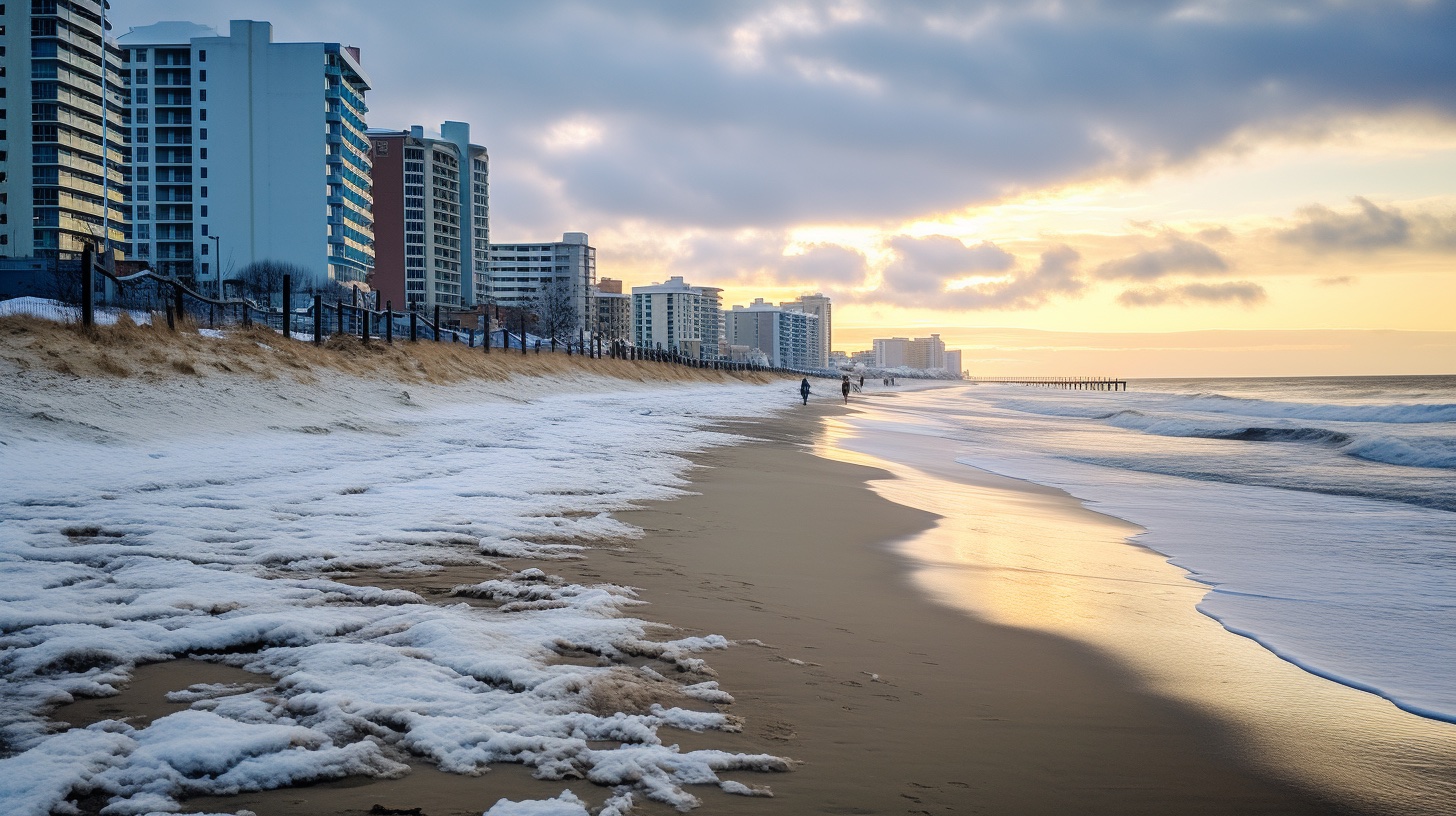Welcome to our in-depth guide on Virginia Beach weather. Whether you’re planning a vacation, a day trip, or just curious about the local climate, this article will provide you with everything you need to know. From seasonal changes to what to pack, we’ve got you covered.
Table of Contents
ToggleIntroduction to Virginia Beach Weather
Virginia Beach, located on the southeastern coast of Virginia, boasts a diverse climate that attracts visitors year-round. The city’s weather is influenced by its coastal location, providing a mix of warm summers, mild winters, and pleasant springs and autumns.
Geographical Influence on Weather
The Atlantic Ocean plays a significant role in shaping Virginia Beach’s weather. The proximity to the ocean moderates temperatures, ensuring that summers are not too hot and winters are relatively mild. This maritime influence makes Virginia Beach an ideal destination for those seeking a balanced climate.
Seasonal Overview
Spring: Blooming Beginnings
Spring in Virginia Beach is a delightful season, with temperatures gradually rising from the cooler winter months.
Weather Patterns in Spring
- March: Temperatures range from 45°F to 60°F.
- April: Expect temperatures between 55°F and
70°F.
- May: Enjoy warmer days with temperatures ranging from 65°F to 75°F.
The spring season is characterized by blooming flowers and an increase in outdoor activities. Light jackets and layers are recommended for comfort during this transitional period.
Summer: Sun and Fun
Summer is the peak tourist season in Virginia Beach, thanks to its warm and sunny weather. The beaches are bustling with visitors enjoying the sun, sand, and surf.
Weather Patterns in Summer
- June: Temperatures range from 70°F to 85°F.
- July: The hottest month, with temperatures ranging from 75°F to 90°F.
- August: Similar to July, with temperatures between 75°F and 88°F.
Because of the often high humidity, it’s critical to wear sunscreen and drink plenty of water. Lightweight clothing, hats, and sunglasses are recommended for those spending time outdoors.
Fall: Crisp and Colorful
Fall in Virginia Beach is a beautiful season, marked by cooler temperatures and vibrant foliage. It’s the ideal season for festivals and outdoor pursuits.
Weather Patterns in Fall
- September: Temperatures range from 70°F to 80°F.
- October: Cooler temperatures between 60°F and 70°F.
- November: Expect temperatures from 50°F to 60°F.
Layers are ideal for fall, as the weather can vary throughout the day. This season offers a picturesque setting for visitors to enjoy.
Winter: Mild and Manageable

Winter in Virginia Beach is relatively mild compared to other parts of the country. Snowfall is rare, and temperatures remain comfortable for outdoor activities.
Weather Patterns in Winter
- December: Temperatures range from 40°F to 55°F.
- January: The coldest month, with temperatures between 35°F and 50°F.
- February: Slightly warmer, with temperatures ranging from 40°F to 55°F.
A warm coat and layers are advisable for winter visits. The mild climate allows for continued enjoyment of the beach and outdoor attractions.
Monthly Breakdown
January: A Fresh Start
January is the coldest month, but the weather remains manageable. Visitors can enjoy quiet beaches and local attractions without the summer crowds.
February: A Hint of Spring
February sees a slight increase in temperatures, offering a hint of the approaching spring. It’s a great time for off-season travel deals.
March: Spring Awakenings
March brings the first signs of spring, with blooming flowers and more pleasant weather. Outdoor activities become more enjoyable.
April: Full Bloom
April is a beautiful month in Virginia Beach, with gardens and parks in full bloom. The weather is perfect for exploring the outdoors.
May: Warming Up
May offers warm, comfortable weather, making it an ideal time for beach visits and outdoor events.
June: Start of Summer
June marks the beginning of the summer season. The weather is warm, and the beaches are becoming more crowded.
July: Peak Summer
July is the peak of summer, with hot and sunny days perfect for beach activities and water sports.
August: Midsummer Magic
August continues the summer fun, with warm weather and plenty of outdoor activities to enjoy.
September: Transition to Fall
September brings slightly cooler temperatures and fewer tourists, making it a great time to visit.
October: Autumn Colors
October is a beautiful month with vibrant fall colors and cooler temperatures, perfect for exploring nature trails.
November: Crisp Air
November offers crisp, cool air and a peaceful atmosphere. It’s an excellent time for enjoying the quieter side of Virginia Beach.
December: Holiday Cheer
December brings mild winter weather and festive holiday events. It’s a wonderful time to experience the local culture.
What to Pack for Virginia Beach
Spring Packing Tips
- Light jackets and sweaters
- Comfortable walking shoes
- Layered clothing
Summer Packing Tips
- Lightweight clothing
- Swimwear and beach gear
- Sunscreen and sunglasses
Fall Packing Tips
- Layered clothing
- Comfortable walking shoes
- Light jackets
Winter Packing Tips
- Warm coats and sweaters
- Layered clothing
- Comfortable walking shoes
Outdoor Activities by Season
Spring Activities
- Beachcombing
- Hiking and biking
- Visiting botanical gardens
Summer Activities
- Swimming and surfing
- Beach volleyball
- Kayaking and paddleboarding
Fall Activities
- Scenic drives
- Hiking and nature walks
- Attending fall festivals
Winter Activities
- Beach walks
- Visiting local museums
- Holiday events and markets
Conclusion
Virginia Beach offers a diverse and appealing climate year-round. Whether you prefer the warm summers or the mild winters, there’s always something to enjoy. Planning your visit according to the weather will ensure a memorable and comfortable experience.
Visit Now: 10 Best Water Parks in Virginia Beach: Chill and Enjoy
FAQs
Q1. What is the best time to visit Virginia Beach?
The best time to visit Virginia Beach is during the spring and fall when the weather is pleasant and the tourist crowds are smaller.
Q2. Does Virginia Beach get hurricanes?
Yes, Virginia Beach can experience hurricanes, primarily during the hurricane season from June to November. It's essential to stay informed about weather forecasts during this period.
Q3. How cold does it get in Virginia Beach during winter?
Winter temperatures in Virginia Beach are relatively mild, typically ranging from 35°F to 55°F. Snowfall is rare.
Q4. What should I pack for a summer trip to Virginia Beach?
For a summer trip, pack lightweight clothing, swimwear, sunscreen, sunglasses, and a hat to protect yourself from the sun.
Q5. Are there any indoor activities in Virginia Beach for rainy days?
Yes, Virginia Beach offers several indoor activities such as visiting museums, aquariums, and shopping centers. There are plenty of options to stay entertained even on rainy days.
Q1. What is the best time to visit Virginia Beach?
The best time to visit Virginia Beach is during the spring and fall when the weather is pleasant and the tourist crowds are smaller.
Q2. Does Virginia Beach get hurricanes?
Yes, Virginia Beach can experience hurricanes, primarily during the hurricane season from June to November. It’s essential to stay informed about weather forecasts during this period.
Q3. How cold does it get in Virginia Beach during winter?
Winter temperatures in Virginia Beach are relatively mild, typically ranging from 35°F to 55°F. Snowfall is rare.
Q4. What should I pack for a summer trip to Virginia Beach?
For a summer trip, pack lightweight clothing, swimwear, sunscreen, sunglasses, and a hat to protect yourself from the sun.
Q5. Are there any indoor activities in Virginia Beach for rainy days?
Yes, Virginia Beach offers several indoor activities such as visiting museums, aquariums, and shopping centers. There are plenty of options to stay entertained even on rainy days.



